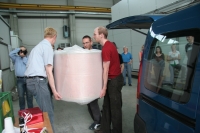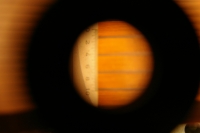 |
 |
|||||||||||||
|
|||||||||||||
|
|||||||||||||
The international time projection chamber (TPC) team that works on R&D for future ILC detectors used to have a bit of a running gag. Somebody would proclaim that “the field cage will arrive next week” and everybody else would chuckle because week after week it didn’t arrive. Chuckling days are over now: after several years of planning the cage for the large TPC prototype, ordering it from industry, checking the quality, rejecting parts of the product and reordering, the nearly one-metre-long barrel with an inner diameter of 72 centimetres has finally arrived at DESY in Hamburg. First tests indicate that it will finally meet the team's high requirements. A time projection chamber is not a science fiction gadget but a highly precise detector that lets scientists reconstruct the track of a passing charged particle in three dimensions. It is basically a cylinder filled with gas, permeated by a high electric field. It is one of the detectors that are closest to the interaction point at which electrons and positrons will collide in the ILC. When a charged particle passes through the gas, it ionises the gas molecules it hits, knocking out their electrons. These electrons drift along through the electric field to the anode, the 'plus pole' of the electric field, where they are read out. This drift is where the field cage comes in. The electric field inside the TPC has to be very homogenous. If it wasn't, the drifting electrons could be veered off their path and the pass of the charged particle could not be reconstructed properly anymore. The inside wall of the field cage is coated by a film made up many fine copper rings, each 2.3 millimetres wide. They ensure that the potential changes smoothly from the cathode to the anode. These rings were the greatest challenge and one reason why the arrival of the field cage took so much longer than expected that people started to make jokes about it. One of the main areas where the ILC TPCs need new technology are anode readout structures that amplify and time the signal of the arriving electrons. Several groups are investigating several technologies like Micromegas (MICRO-MEsh GASeous detector) or GEMs (gas electron multipliers). At DESY, the main focus is on GEMs, which have been tested in small versions on smaller TPC prototypes but can now, with the help of the larger field cage, be built and studied in larger structures. The endplate that will hold the large GEM modules was built by Dan Peterson's group at Cornell University and is expected at DESY in the next weeks. The field cage barrel is made of a honeycomb structure with a very low material budget — a requirement for the TPC to deflect the particles as little as possible. Planning the structure and preliminary tests took several months, then first trial versions of the walls and copper strips started passing hands. However, the company that the team had originally picked for the production of the copper strips admitted after several months that they would not be able to meet the team's tough requirements. “We had to pick another company, which delayed the process by a couple of months,” explains Peter Schade, a PhD student at DESY working on the field cage project. “We are so pleased to finally have the cage here at DESY,” he says. At the moment the team members are doing some tests on the cage's mechanical and high-voltage tolerances. After that, once the readout endplate has arrived from Cornell, they will be tested inside the magnet called 'PCMAG'. One of the tasks of the EU-funded EUDET programme was to make a complete map of this magnet's field. The result show that it is quite inhomogeneous - just the thing the ILC TPC group needs. “The future ILC detectors' magnetic fields are likely to be inhomogeneous as well,” says Schade. “Testing our prototype in such a field will teach us how to run and correct the TPC accordingly.” -- Barbara Warmbein And here the solution to last week's 'What is it': the picture showed the copper strips on the inside of the TPC's field cage. Congratulations to Franziska Hegner. |
|||||||||||||
| © International Linear Collider |


